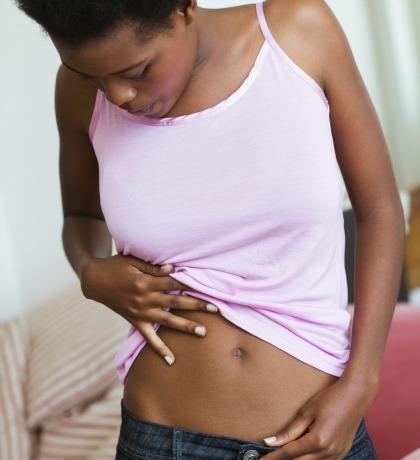How Your Vagina Changes As You Age
How Your Vagina Changes With Age
Share the post
Share this link via
Or copy link
You and your vagina have a life-long relationship, and like all really great relationships, this one evolves, transforms, goes through slumps, enjoys high points, and changes over the years. A lot of women don’t realize that their vagina changes much because, well, it’s not exactly like they stare at it in the mirror every day. We notice that our skin changes, that our hair changes, that our stamina changes…but we don’t always notice what’s going on downstairs. But it’s important to pay attention because your va-jay-jay’s health and appearance tell you a lot about other things happening in your body. It’s also just important to pay attention, so you’re not greeted with any unpleasant surprises. Here is how your vagina changes with age (besides becoming wiser).

Image Source: Shutterstock
Your 20s: Infections galore
Why? Simply because you’re not educated yet. Women in their twenties work out at the gym and go directly to brunch, sitting in their sweaty clothes and developing UTIs. They also tend to eat diets higher in sugar, because their figure can still handle it, but this can cause yeast infections.
- Love Or Liability? How Romantic Relationships Really Impact Your Wallet
- From Basic To Bomb: 5 Ways To Elevate Your Sex Game This Summer
- Gym Etiquette 101: 10 Rules Every Respectful Member Should Follow
- Protected: The Sound Of Movement: Ledisi Reflects On The Power Of Protest Music And Self-Love In ‘The Crown’
- Terrence Howard Bashed For Rejecting Marvin Gaye Biopic Over Gay Kiss Scene
Your 20s/30s: dryness
You may have heard that women hit their sexual peak a little later in life, and this may have something to do with it: earlier in life, most women are on the pill, and the pill can cause dryness down south. Dryness isn’t exactly conducive to the best sex of your life.
- Love Or Liability? How Romantic Relationships Really Impact Your Wallet
- From Basic To Bomb: 5 Ways To Elevate Your Sex Game This Summer
- Gym Etiquette 101: 10 Rules Every Respectful Member Should Follow
- Protected: The Sound Of Movement: Ledisi Reflects On The Power Of Protest Music And Self-Love In ‘The Crown’
- Terrence Howard Bashed For Rejecting Marvin Gaye Biopic Over Gay Kiss Scene

Image Source: Shutterstock
Your 30s: veins
The thirties is an age when most women choose to have their first child. Pregnancy and childbirth can, in fact, result in varicose veins downstairs. But they can go away.
- Love Or Liability? How Romantic Relationships Really Impact Your Wallet
- From Basic To Bomb: 5 Ways To Elevate Your Sex Game This Summer
- Gym Etiquette 101: 10 Rules Every Respectful Member Should Follow
- Protected: The Sound Of Movement: Ledisi Reflects On The Power Of Protest Music And Self-Love In ‘The Crown’
- Terrence Howard Bashed For Rejecting Marvin Gaye Biopic Over Gay Kiss Scene

Image Source: Tumblr
Your 30s: a weird colored vulva
The hormones that surge through your body during pregnancy can actually cause discoloration in your vulva. Many women notice their vulva appearing slightly darker during and after pregnancy.
- Love Or Liability? How Romantic Relationships Really Impact Your Wallet
- From Basic To Bomb: 5 Ways To Elevate Your Sex Game This Summer
- Gym Etiquette 101: 10 Rules Every Respectful Member Should Follow
- Protected: The Sound Of Movement: Ledisi Reflects On The Power Of Protest Music And Self-Love In ‘The Crown’
- Terrence Howard Bashed For Rejecting Marvin Gaye Biopic Over Gay Kiss Scene

Shutterstock
Your 30s: a weak pelvis
Since most women who have children have their first ones in their 30s, they also experience a weakened pelvis around this time. Fortunately, there are exercises you can do to fix that.
- Love Or Liability? How Romantic Relationships Really Impact Your Wallet
- From Basic To Bomb: 5 Ways To Elevate Your Sex Game This Summer
- Gym Etiquette 101: 10 Rules Every Respectful Member Should Follow
- Protected: The Sound Of Movement: Ledisi Reflects On The Power Of Protest Music And Self-Love In ‘The Crown’
- Terrence Howard Bashed For Rejecting Marvin Gaye Biopic Over Gay Kiss Scene

Image Source: Shutterstock
Your 40s: wetness returns
Because, at this time, some women have been off the pill for a few years (or at least been inconsistent with it) while having children, many report a renewed moisture down south.
- Love Or Liability? How Romantic Relationships Really Impact Your Wallet
- From Basic To Bomb: 5 Ways To Elevate Your Sex Game This Summer
- Gym Etiquette 101: 10 Rules Every Respectful Member Should Follow
- Protected: The Sound Of Movement: Ledisi Reflects On The Power Of Protest Music And Self-Love In ‘The Crown’
- Terrence Howard Bashed For Rejecting Marvin Gaye Biopic Over Gay Kiss Scene

Shutterstock
Your 40s: Pigment problems
By your 40s, it’s possible that you’ve been waxing down south for twenty years. That’s a lot of upkeep. And the process can lead to a change of pigmentation down south.
- Love Or Liability? How Romantic Relationships Really Impact Your Wallet
- From Basic To Bomb: 5 Ways To Elevate Your Sex Game This Summer
- Gym Etiquette 101: 10 Rules Every Respectful Member Should Follow
- Protected: The Sound Of Movement: Ledisi Reflects On The Power Of Protest Music And Self-Love In ‘The Crown’
- Terrence Howard Bashed For Rejecting Marvin Gaye Biopic Over Gay Kiss Scene

Corbis
Your 40s: Less hair
Maybe removing all of that hair for twenty years paid off because, by their forties, many women report their pubic hairs thinning. That should be easier on your razor.
- Love Or Liability? How Romantic Relationships Really Impact Your Wallet
- From Basic To Bomb: 5 Ways To Elevate Your Sex Game This Summer
- Gym Etiquette 101: 10 Rules Every Respectful Member Should Follow
- Protected: The Sound Of Movement: Ledisi Reflects On The Power Of Protest Music And Self-Love In ‘The Crown’
- Terrence Howard Bashed For Rejecting Marvin Gaye Biopic Over Gay Kiss Scene

Image Source: Shutterstock
Your 40s: rougher skin
Many women also report that their skin down there doesn’t feel quite as soft and buoyant as it did in their twenties. This could be a result of the body changing, and struggling to produce the plumping moisture that’s important to keeping all skin buoyant. It could also be a response to years of shaving and waxing.
- Love Or Liability? How Romantic Relationships Really Impact Your Wallet
- From Basic To Bomb: 5 Ways To Elevate Your Sex Game This Summer
- Gym Etiquette 101: 10 Rules Every Respectful Member Should Follow
- Protected: The Sound Of Movement: Ledisi Reflects On The Power Of Protest Music And Self-Love In ‘The Crown’
- Terrence Howard Bashed For Rejecting Marvin Gaye Biopic Over Gay Kiss Scene

Image Source: Shutterstock
Your 50s: new dryness
Hormonal changes in your early fifties, related to perimenopause, can cause a new dryness downstairs.
- Love Or Liability? How Romantic Relationships Really Impact Your Wallet
- From Basic To Bomb: 5 Ways To Elevate Your Sex Game This Summer
- Gym Etiquette 101: 10 Rules Every Respectful Member Should Follow
- Protected: The Sound Of Movement: Ledisi Reflects On The Power Of Protest Music And Self-Love In ‘The Crown’
- Terrence Howard Bashed For Rejecting Marvin Gaye Biopic Over Gay Kiss Scene

Image Source: Shutterstock.com
Your 50s: less elasticity
Premenopausal changes can also lead to less elasticity in the vulva. Many women report the vulva feeling thinner and dryer, too.
- Love Or Liability? How Romantic Relationships Really Impact Your Wallet
- From Basic To Bomb: 5 Ways To Elevate Your Sex Game This Summer
- Gym Etiquette 101: 10 Rules Every Respectful Member Should Follow
- Protected: The Sound Of Movement: Ledisi Reflects On The Power Of Protest Music And Self-Love In ‘The Crown’
- Terrence Howard Bashed For Rejecting Marvin Gaye Biopic Over Gay Kiss Scene

Shutterstock
Your 50s: Urgency
Many of the changes we already mentioned, like dryness and thinness of the vulva, can cause irritation during sex that makes a woman constantly feel that she needs to pee after sex.
- Love Or Liability? How Romantic Relationships Really Impact Your Wallet
- From Basic To Bomb: 5 Ways To Elevate Your Sex Game This Summer
- Gym Etiquette 101: 10 Rules Every Respectful Member Should Follow
- Protected: The Sound Of Movement: Ledisi Reflects On The Power Of Protest Music And Self-Love In ‘The Crown’
- Terrence Howard Bashed For Rejecting Marvin Gaye Biopic Over Gay Kiss Scene

Image Source: Shutterstock
Your 50s: more infections
During menopause, your estrogen levels decrease which in turn affect your pH levels. Any time your pH levels are out of whack, your vagina is at a higher risk of infections.
- Love Or Liability? How Romantic Relationships Really Impact Your Wallet
- From Basic To Bomb: 5 Ways To Elevate Your Sex Game This Summer
- Gym Etiquette 101: 10 Rules Every Respectful Member Should Follow
- Protected: The Sound Of Movement: Ledisi Reflects On The Power Of Protest Music And Self-Love In ‘The Crown’
- Terrence Howard Bashed For Rejecting Marvin Gaye Biopic Over Gay Kiss Scene

Shutterstock
Your 60s: Muscle spasms
At his point, if you haven’t taken the right steps to fight things like vaginal dryness and other symptoms of menopause, sex may have become painful. As a defense mechanism, your pelvic muscles might spasm when they sense intercourse is about to happen, and that can make it more uncomfortable.
- Love Or Liability? How Romantic Relationships Really Impact Your Wallet
- From Basic To Bomb: 5 Ways To Elevate Your Sex Game This Summer
- Gym Etiquette 101: 10 Rules Every Respectful Member Should Follow
- Protected: The Sound Of Movement: Ledisi Reflects On The Power Of Protest Music And Self-Love In ‘The Crown’
- Terrence Howard Bashed For Rejecting Marvin Gaye Biopic Over Gay Kiss Scene

Shutterstock
Your 60s: Prolapse
Prolapse is when parts of the uterus or cervix begin to droop. Every woman is at risk for this when she gives birth, but if she avoids it then, she’s at risk again in her 60s when looseness becomes a problem. If this happens to you, there is a surgery that can fix it.
- Love Or Liability? How Romantic Relationships Really Impact Your Wallet
- From Basic To Bomb: 5 Ways To Elevate Your Sex Game This Summer
- Gym Etiquette 101: 10 Rules Every Respectful Member Should Follow
- Protected: The Sound Of Movement: Ledisi Reflects On The Power Of Protest Music And Self-Love In ‘The Crown’
- Terrence Howard Bashed For Rejecting Marvin Gaye Biopic Over Gay Kiss Scene








